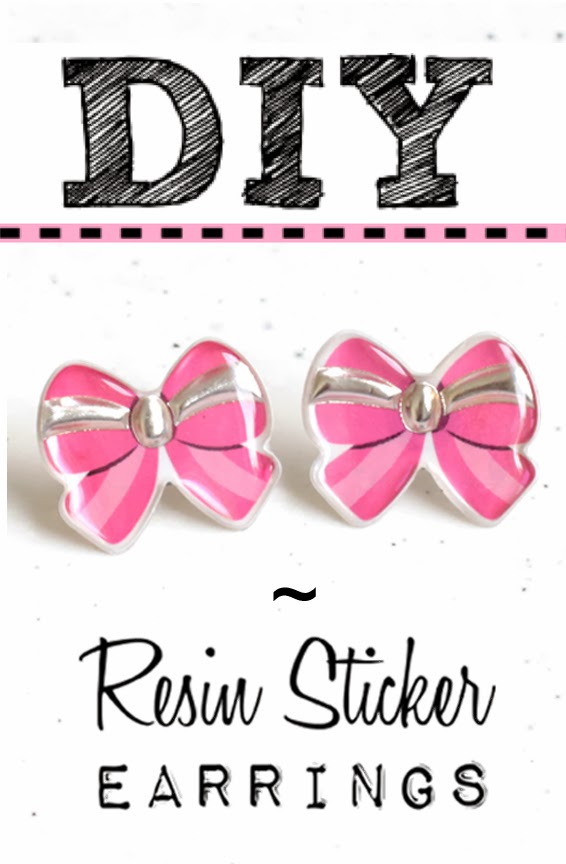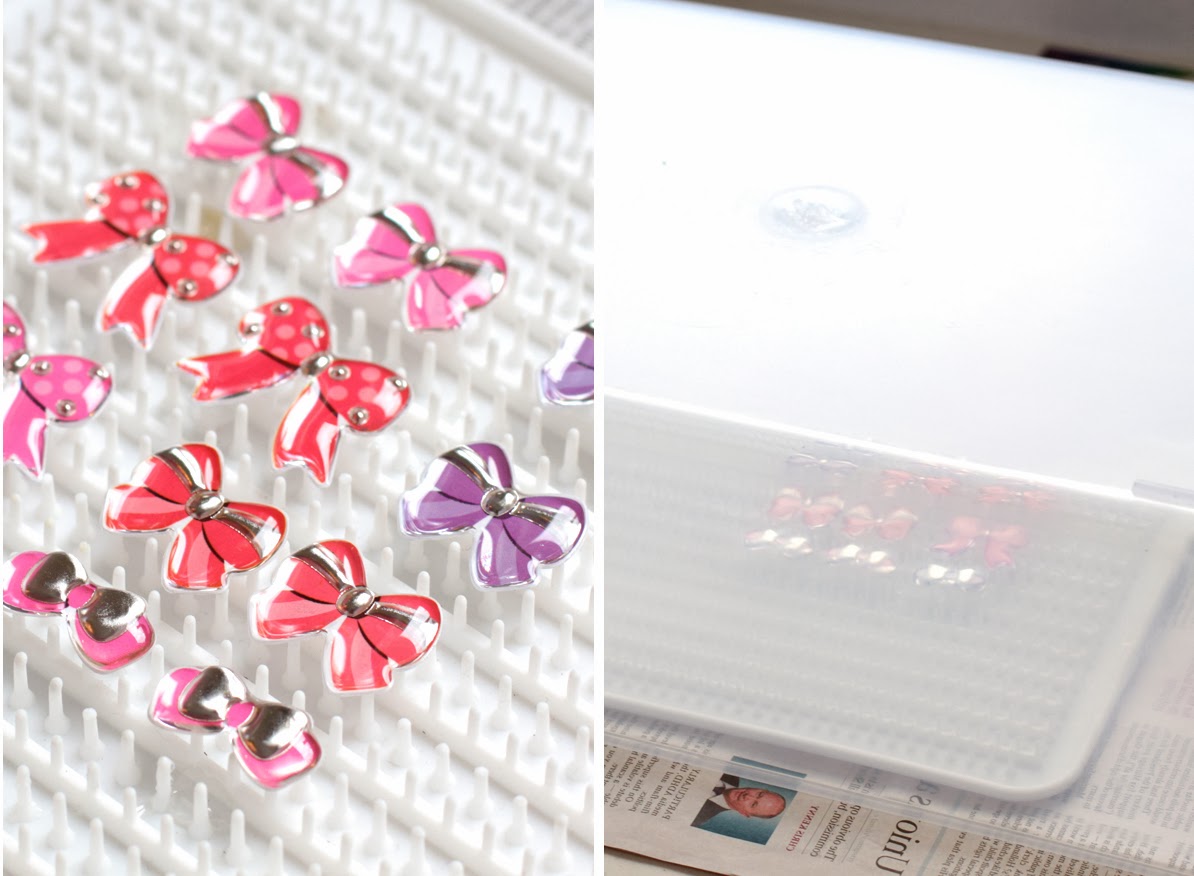DIY Resin Post Earrings Made with Stickers! (Doming Technique)
I first started working with resin about a year ago and have absolutely loved it. Although I’ve found it a little challenging at times (spillages, bubbles, resin setting too fast, or not setting at all), the results have been well worth it. So I thought it was about time I started some tutorials here to hopefully inspire you to try it out too.
This is a beginner’s resin tutorial on the doming technique. Although its reasonably easy, I suggest that if you are completely new to resin that you first try casting into moulds (just to help you get a sense of the resin). I hope to do a tutorial on that in the coming weeks (I have something coming that I’m just waiting to arrive). There are some great tutorials on youtube for beginners so I recommend looking there.
You will need:
Jeweller’s Resin, Plastic Coated Stickers (or any flat image – see note just below a bit), earring posts, stirring wands, small measuring cup, timer, rubber gloves, paper towel, plastic sheet (from display book) or a doming tray, plastic box to cover resin from dust, kebab sticks, a fine-tipped marker pen to make the measuring cup, gas mask (if your sensitive to fumes).
Purchasing Resin:
You should be able to buy jeweller’s resin from most craft shops. Most resin kits come with measuring cups and stirring wands too.
You can get it online in Australia from Over The Rainbow. In the States I know Fire Mountain Gems sells some, Amazon too. Little Windows Resin (my favourite so far) is available through their website. They ship internationally, have great prices and great service too. They also have the most amazing resin supplies.
Caution:
Certain Resins can give off toxic fumes, so you’ll need to work in a well ventilated area. If you’re working outside you need to make sure that your work surface is completely flat and that nothing will blow away. I personally find it too difficult working outside. Wearing a gas mask can help and even some clear glasses if it irritates your eyes too much. One of the reason why Little Windows Resin is my favourite is because it’s non-toxic and really doesn’t give off any fumes at all. It uses less chemical hardener, and doesn’t contain solvents or the usual nasties. It also gives the best results and least amount of bubbles than any resin I’ve tried.
My Set Up:
When working with resin I find it’s really important to have everything in place before you start. Once you’ve mixed up a batch you’ll have approximately 20-30 mins working time – so you need to move quickly. Having everything in front of will really help, especially if you are just learning. This is my set-up here, if you can see I even have a checklist I use to make sure I’m completely organised! (It’s easy to forget things) Once you’ve made the resin you won’t want to move it for at least 12hours, so make sure you work in a space that you can leave it.
Instead of Stickers:
Instead of stickers you can use anything – magazine clippings, photos, drawings, paper stickers, wrapping paper etc. You will just need to coat them back and front with a couple of layers of sealant, such a Mod Podge (I like the paper one/green label best). You may need to flatten them in a book afterwards as they tend to curl up.
Instructions:
1. Place selected pieces on a doming tray or sheet of plastic (I just use an A4 pieces from a display book). A doming tray catches any spilt resin so that it won’t stick to your pieces. If you’re just using a sheet of plastic make sure to spread the pieces out (more than pictured) so that if you do spill any resin (it does happen) it won’t disturb the rest of the pieces. Take a chance to check for any dust on the pieces too, use a blower brush or a soft cloth to wipe any that need it.
2. Mark the measuring cup for both the amount of resin and hardener you’ll need according to your resin’s instructions (most resin’s are a 1:1 ratio, the one I’m using is a 2:1 though). Mix the the resin SLOWLY, if you mix it too fast you’ll get lots of bubbles. Also make sure to scrape the resin from around the sides and from the spatula into the cup every once in a while so that it’s all mixed evenly. For a small batch like this I usually mix it for about 3 mins, until the swirls disappear and the resin clears. Leave the resin to rest for about 5mins (check your exact instructions for this too). After it’s rested you can remove any bubbles from the surface with the spatula.
3. Carefully get a small amount of resin onto the spatula and let it drip over one of the stickers. The resin will form to the exact shape or your pieces. When it hits the edge, it will stop. As long as you don’t put too much on it won’t overflow. If you do have resin that overflows and you are using plastic or a lower doming tray, you will need to move the piece to a clean area of the board so that it doesn’t stick.
4. If the resin doesn’t find the edges of the stickers by itself you can encourage it with a toothpick or kebab stick.
Hopefully you won’t have bubbles, I do have a couple (as you might be able to see here). Sometimes you can lift the bubble out or pop it with the stick. Quite often the bubbles will pop by themselves after a few minutes anyway. Some resins I’ve used have had a lot of bubbles, others not so many. It can also be dependant of the temperature too and definitely how quickly you mix the batch. I’ve had the most success with the little windows resin though, I hardly get any bubbles with this one. If you do have a stubborn bubble that you just can’t pop or lift out you can try waving a lit match about an inch above the piece. The fire will draw up the oxygen from the bubble. It works well but only do this as a last retort and carefully too. I have seen resin artists that use this as well as warnings written against it (although I am yet to come across a reason why this is bad??) I have burnt and discoloured pieces in the past when doing this so that might be one reason why. If you do this just be careful :)
5. After all the pieces are done, cover them with a plastic box or container to prevent dust. Let them dry for at least a day.
6. After a day they will ready to touch. Don’t worry if they are still a bit pliable (the resin takes a few days to harden completely).
7. Set up your work area as before, make sure to have earring post findings on hand too. For the reverse side I do them straight onto plastic as the curve of the set resin makes it harder to position them on the doming tray. You should spread these out more than I have here too as it can get messy. I forgot to think about this for the photo – whoops!
8. Spread out the pieces like I’ve done here. Drip resin onto the pieces as before, using a stick to move any up to edges. You’ll probably only want a thin layer of resin for the back. If you like, you can colour it with resin dye, oil paint, glitter or mica powder. I just left it clear for these.
9. Drop a post finding carefully in the centre. Position with the kebab stick. It should stay in place. If you are worried about it moving though (sometimes they do slightly), you can always glue it in place before hand.
10. Let them to dry under the plastic box for another day.
They are ready! They worked out really well I think. I was slightly worried that the resin might seek through the sticker backings and darken the design somewhat – but it didn’t. As you can see I did stuff a couple up – the two in the front I spilt resin over so they ended up completely flat rather than domed. They they still look ok but I didn’t bother putting studs on them.
As the resin shortens the length of the studs slightly you might find you can only use the nut backs (as pictured) or smaller plastic backs rather than large, circular comfort backs. See how you go though. You can always stick the posts directly onto the backings after the resin’s dried too.
I hope you enjoyed this tutorial. Resin is really fun and definitely worth something to try out as the results are so lovely and look so professional too. Don’t be disheartened if this takes you a couple of goes – it took me ages to get consitently good results with this. If you have any questions or problems don’t hesitate to contact me, I’m always happy to help.
Have you ever made resin jewellery? I’d love to hear what you’ve created. If you try out this technique make sure to let me know how you go :)
Linking up with: Get Your Pretty On, Friday’s Fab Favourites, Our Sunday Best Showcase,




















@
this is amazing!!! you make it look so easy!!!
thanks for linking up with Fab Favorites!!
xxAmber
@
Thanks so much Amber! Glad you liked it – and thanks for a fun link-up to :)
@
I’m so impressed…these are really cute earrings and I never would have though of using stickers! :)
@
Thanks so much Merrie! I love using anything to make these but stickers make it so easy and they tend to be really cute too :)
@
Thanks..Amelia Madeleine
Thanks for posting these bow earrings. I was searching bow earrings from many days. finally I found your blog and complete my search.
@
Oh great! Thanks so much. Glad to hear you like these :)
@
Hi there! I just recently started making earrings out of stickers. A lot of the stickers I use are 3D paper stickers. I’m trying to find a way to seal or harden them so that they are more sturdy and somewhat water resistant. I tried mod podge, but it curled up my stickers and didn’t harden them at all. So I looked into this whole resin business to see if this is the route I should go. Would this resin tequnique work for 3D paper stickers(some with multiple layers)?? Thanks so much! :)